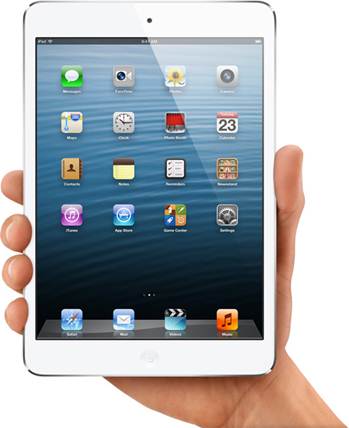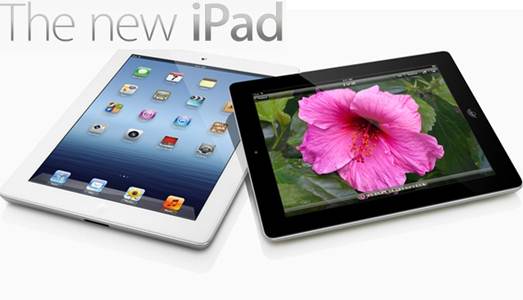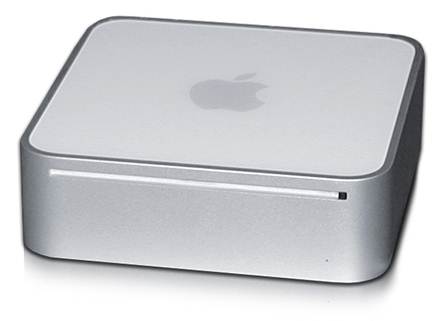Refresh also sees slimmer iMac,
faster iMac mini and a MacBook Pro 13in with Retina display
Apple couldn’t keep the launch of its
widely anticipated iPad mini a secret, but it did pull off a shock unveiling
another new iPad in its biggest product shake up in recent memory.
CEO Tim Cook took to the stage alongside
Phil Schiller, head of marketing, to reveal the much rumoured 7.9in iPad mini a
form factor that Steve Jobs famously derided as too small, saying users would
have to “sand down” their fingertips.

Ipad
mini
Apple’s opinion has been swayed by the
success of the Amazon Kindle Fire HD and the Google Nexus 7, but Schiller was
quick to stress the company’s 7.9in device is much larger than its rivals, with
a third more screen space than the Nexus 7. Since it’s the same resolution as
the iPad 2, apps designed for the larger tablet will still work. Schiller also
pointed out it’s much thinner and lighter although he didn’t compare the price.
The Bottom End 16GB Wi-Fi only iPad mini costs $403.5, compared to the 16GB
Nexus 7 at $298.5 and the 16GB Kindle Fire HD at $238.5 and it’s double the
price of the 8GB Kindle Fire at $193.5.
Schiller dismissed gripes about the price.
“The iPad is far and away the most successful product in its category,”
Schiller told Reuters. “The most affordable product we’ve made so far was $399
and people were choosing that over those devices.”
However, the biggest challenger to the iPad
mini may be its bigger brother. The iPad 2 with the same 1,024 x 768 resolution
screen costs only $90 more.
New iPad upgraded
A bigger surprise than the iPad mini is the
upgrade to the full-sized iPad. The fourth generation of the tablet now
features the Lightning connector, an HD FaceTime camera, faster Wi-Fi, extended
LTE support, and a new A6X chip, which Apple said offered twice the CPU and
graphics performance of its predecessor all for the same price as the
third-generation iPad, which has been withdrawn from sale.

Apple normally updates the iPad at the beginning
of the year, which has lead to complaints from third-generation “new” iPad
owners. Reports suggested some retailers were bought in the previous mouth, but
the update has raised fears over Apple’s accelerating refresh cycle, and
whether it would have any new hardware to announce in the first half of next
year.
Mac revamp
Apple has also refreshed its laptop and
desktop models, slimming down the iMac, bringing a Retina display to the
MacBook Pro 13in, and updating the Mac mini. The most eye catching update is
the iMac, which Apple claims is 80% thinner than its predecessor, with an edge
that’s only 5mm thick. It comes with the latest Intel Core i5 or i7 chips, and
a new storage system. Customers can choose from either an SSD of up to 768GB or
a hard disk up to 3TB or a combination of the two, called Fusion Drive. That
marries 128GB of flash with either a 1TB or 3TB hard drive, but the iMac views
it all as a single drive, automatically moving the most-used apps to the flash
side for better performance. The 21.5in version starts from $1,648.5 and the
27in from $2,248.5 but pricing for the Fusion Drive option wasn’t available at
the time we went to press.

Mac
mini
While Apple’s iPad and iPhone grab the most
attention, Schiller claimed the MacBook Pro was the top-selling laptop in the
US; the 13in was its best-selling model. That model has now been refreshed with
a 2,560 x 1,600 Retina display for a starting price of $2,173.5 a solid premium
on its $1498.5 non-Retina predecessor, but it also doubles the RAM to 8GB,
switches to an all-flash drive, and it’s slimmer.
The Mac mini has also been updated to
dual-core Intel Core i5 or quad-core i7 processors, which Apple said were twice
as fast as previous versions. It remains the cheapest Mac at $748.5